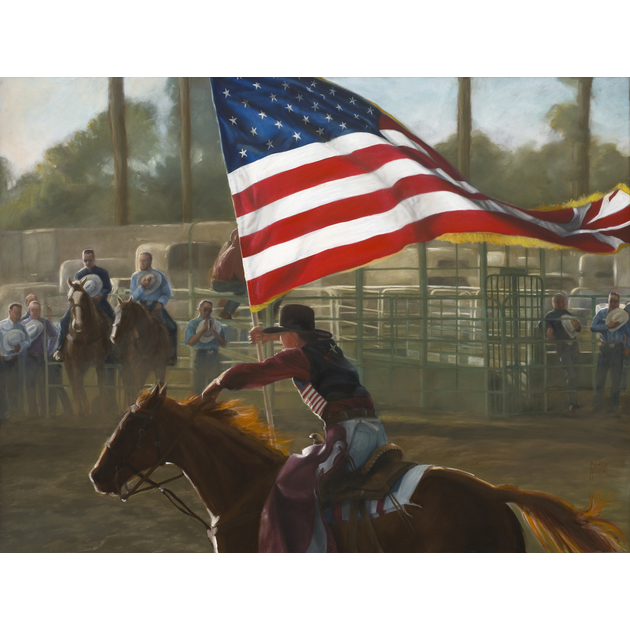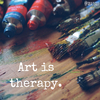Spotlight Artist K. Thompson Paul
Thalo loves to promote artists and each month we spotlight a member of our community!
This month we are pleased to have K. Thompson Paul as the thalo Spotlight Artist for September.

Thalo Team: Can you give an "elevator pitch" of your work?
K. Thompson Paul: I like rich color and juicy applications of paint, yet years of Fashion Illustration and Graphic Design have left their mark on me: keeping my paintings fairly realistic and tight in detail. My struggle now is to override that “photographic copy” mindset with inventiveness and allow mistakes to happen.
TT: What is your artwork about and what do you want people to take from it?
KTP: I am definitely exploring surfaces, but I’m still all over the map in the subjects I am choosing. Like so many artists, I had to give up my art for many years in order to pay the bills; I have only been back to painting for the last three years. Now it’s as if I have found my neighborhood, but not my home. I want to try a few more things.
TT: Which artists do you feel have influenced your art the most?
KTP: Like most artists, I’m mesmerized looking at any great photography, sculpture, architecture, graphic design and illustration. One of my most favorite classes in college was Art History. Now I try to Google what’s going on in the art world weekly, for sure.
I recently discovered the watercolor art of Alvaro Castagnet, Joseph Zbukvic, Tim Wilmot, Ross Patterson, Herman Pekel, and Zhao Zhiqiang. Atmosphere plays an important role in these paintings; you can smell the air in their cityscapes.
An enormous oil painting of Russell Chatham stopped me in my tracks in a Seattle gallery because it had that weight of atmosphere. You never forget seeing great art in person. Locally, I am in awe of Geoffrey Krueger’s landscapes.
In photography, the 8x10 camera work of Christopher Burkett charms me, he likewise produces massive prints, but when you get closer, they have microscopic detail.
TT: Do you have a preferred method of presentation for your artwork and why? (Examples: workshops, gallery shows, Instagram, etc.)
KTP: I prefer galleries—then I can get to know people and get that all-important feedback so I can grow. Unfortunately, Idaho doesn’t have a lot of galleries and there are even fewer buyers. One gallery I know is a stellar example of how a gallery survives in a small city: the owner does an outstanding job maintaining a serious gallery, does custom framing, and manages to sponsor a huge plein air event in June every year. There is a big plein air contingent in this state. When I teach classes at Michaels or Hobby Lobby, everyone wants to paint landscapes.
 "Calico Hiding in Sunflowers"
"Calico Hiding in Sunflowers"
TT: Out of all of your creations (or bodies of work) which one did/do you find the most cathartic in creating?
KTP: Let me answer that as what was the LEAST cathartic and about killed my art.
I love painting faces and that got me into trouble. When I lived in Seattle, I got to know some of the people living on the street and painted their portraits. When I showed them my work afterwards, they were confused and then I was confused. How could I explain politely that it was the harshness in their faces, the brokenness behind their eyes that drew me?
I began to think about art and its place and what it should not do. It is invasive and cruel to be shown an image of how others see you when you have had a tough time. I quit art and went back into graphic design for twenty years.
What did I learn? To consider what I am doing and why. I think there’s much that is noble in avoiding “serious art” for shock value alone. It’s easy to step on an ant—impossible to make one. Beauty lifts. It raises the level of civilization. Beauty is harder to master. That’s not infantile.
TT: When was your “Aha!” moment that led your work to where it is now?
KTP: I am pretty blind without my glasses, so when I first saw the stars as a kid, I couldn’t get over it. I asked my mom, “Have those always been there?” Before that, I always had my eyes inches from what I was looking at, so I marveled in the mountains and valleys of tiny things. I still lean toward the mathematical beauty in the microsphere, but I can also perceive the hand of God taking wide brushstrokes in the high deserts and mountains of Idaho. Unfortunately, that’s my dilemma in creating: keeping safe. I tend to fixate on infinite detail—when I long to be free and expressive!
TT: Do you have any tips or advice for fellow artists based off of your experiences thus far?
KTP: Get ready! Technology is not the friend of the traditional artist, but it is the expediter of strong experiences for the average untrained person. Photographers replaced the portrait painters of earlier days with the ability to capture a precise likeness at a good price. Now we see in turn, the end of the local professional photographer and videographer, just as wheelwrights disappeared in the past. This has been a shock to my husband, a commercial photographer.
In this brave new world of phone photography and Photoshop, the average person wants to make their own art: they paint on tablets with a stylus and create their own digital brushes; they design their own t-shirts and posters; they make their own sculptures with 3D printing. Apps give everyone the satisfaction of creating art without the labor. This is just the start; folks will create their own virtual worlds as an artistic expression.
So, if we are going to teach—our role in the future might be more as a “digital facilitator”.
If we are going to paint—if visual art is to last—it has to hit a nerve that surpasses time and generations; it has to resonate with something deep in the viewer, no matter how it is displayed in a future home. Something that they want to live with that gives them comfort or peace or pleasure. Perhaps the traditional role of the artist will prevail, helping people see what is to be seen. I guess we have to think about that as we run at top speed towards the future.
 "Iris"
"Iris"
TT: What are you working on right now and why?
KTP: I am, alas, starting a series of 20 x 30’s with much detail—but I’m forcing myself to not go smaller than a teeny-tiny 3/0 brush!
TT: What was your first work of art that you were proud of? Where is it now?
KTP: I have a painting I love because of the subject: my dad and his dog. Dad was never easy about having a daughter that was an artist but he and Mom supported me and paid for so many lessons when I was a kid. I owe everything to them and that’s why I still use my maiden name to sign my paintings. They paid for an out-of-state school for me, but requested that I also learn Graphic Design to make a living. Dad has been gone for many years, but the painting hangs in my office. Thanks, Mom and Dad!
TT: Do you take commissions? Why or why not?
KTP: I would love to, if I can generate or find quality reference material to work from. I must give myself every opportunity to pursue excellence.
TT: What do you do when you aren't working on artwork (hobbies, job, etc.)?
KTP: Roaming around the West in our little pop-up Aliner trailer and photographing with my husband.
TT: What is an area in your work that you feel weak in that you want to improve upon and how are you going to get there?
KTP: This is my latest mantra: “No one cares about each blade of grass, silly twit.” I tend to do something over and over again until any liquidity disappears into mindless nitpicking control. I would like to learn to do a painting quickly and be right-on with values. I would like to look and think—and then and only then—to paint. Think of how much time it would save!
I’m also figuring out that life is movement. When you fix something with a hard edge it ceases to live, it looks counterfeit. A black line locks something into space. I noticed lately that too much blending also tends to deaden an area. I want viewers to feel a sun-drenched day or feel a cold wind. I want to make smelly art. Clammy art.
For example, when I draw or paint a horse, I’m trying to move beyond the superficial and try to infuse the heavy weight, muscular barrel, furriness, whiskered, snot-producing, stinky, and lovable wonder that is a horse. Those fuzzy ears! I know that light is moving around shapes with surfaces that grab it in different ways.
 "Miracle"
"Miracle"
TT: How do you overcome art blocks?
KTP: I shift gears and work on something else. Worship music helps—also cleaning the house. The impending doom of cleaning toilets is a great motivator to keep me working enthusiastically on art! Also, when you see something that hits you (usually when you are very busy), take it seriously and write it down or take a picture. I have a backlog of photos on my computer and a file of concept drawings.
TT: Is there something that you would like to share with us that we have not covered, that pertains to you and your work?
KTP: I will never be able to make up for time lost painting while I had my other career. I don’t know if that rings a chord with anyone else, but that is real life. We all have to pay the bills, we get sick, our family needs us, etc. With my limited time left, I want to focus on painting things that I find exciting, not what I am supposed to paint. If I can work a good hard day and make a basic living, I am grateful to have been given the opportunity to do that.
TT: If you have links for your website, Facebook page, Instagram, Twitter, etc. that you would like to share, please include these addresses below.
https://fineartamerica.com/artists/k+thompsonpaul
http://kthompsonpaul.wordpress.com








